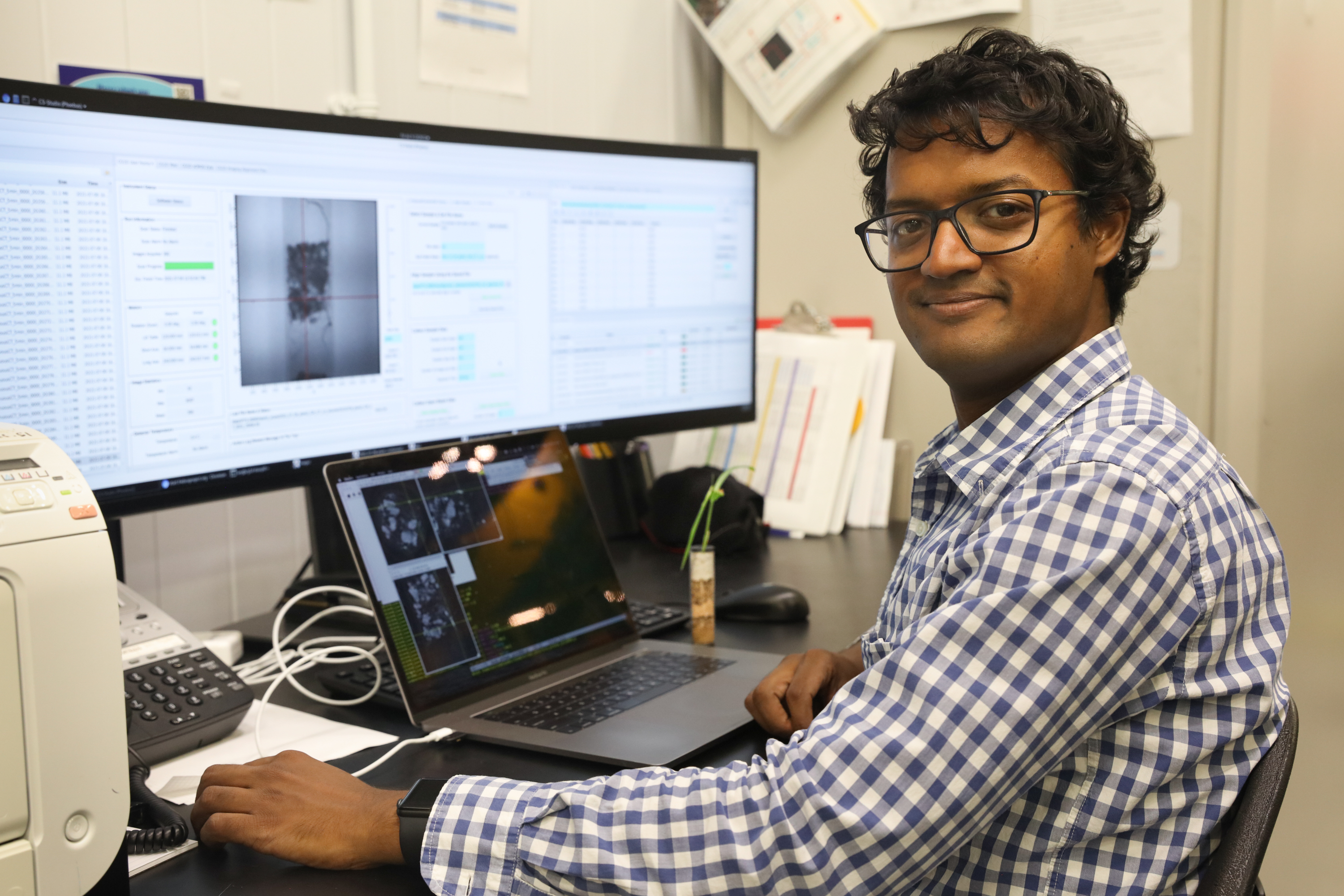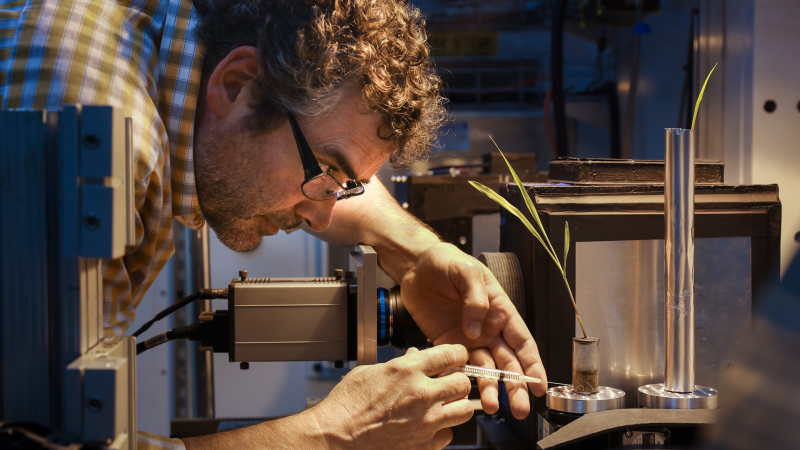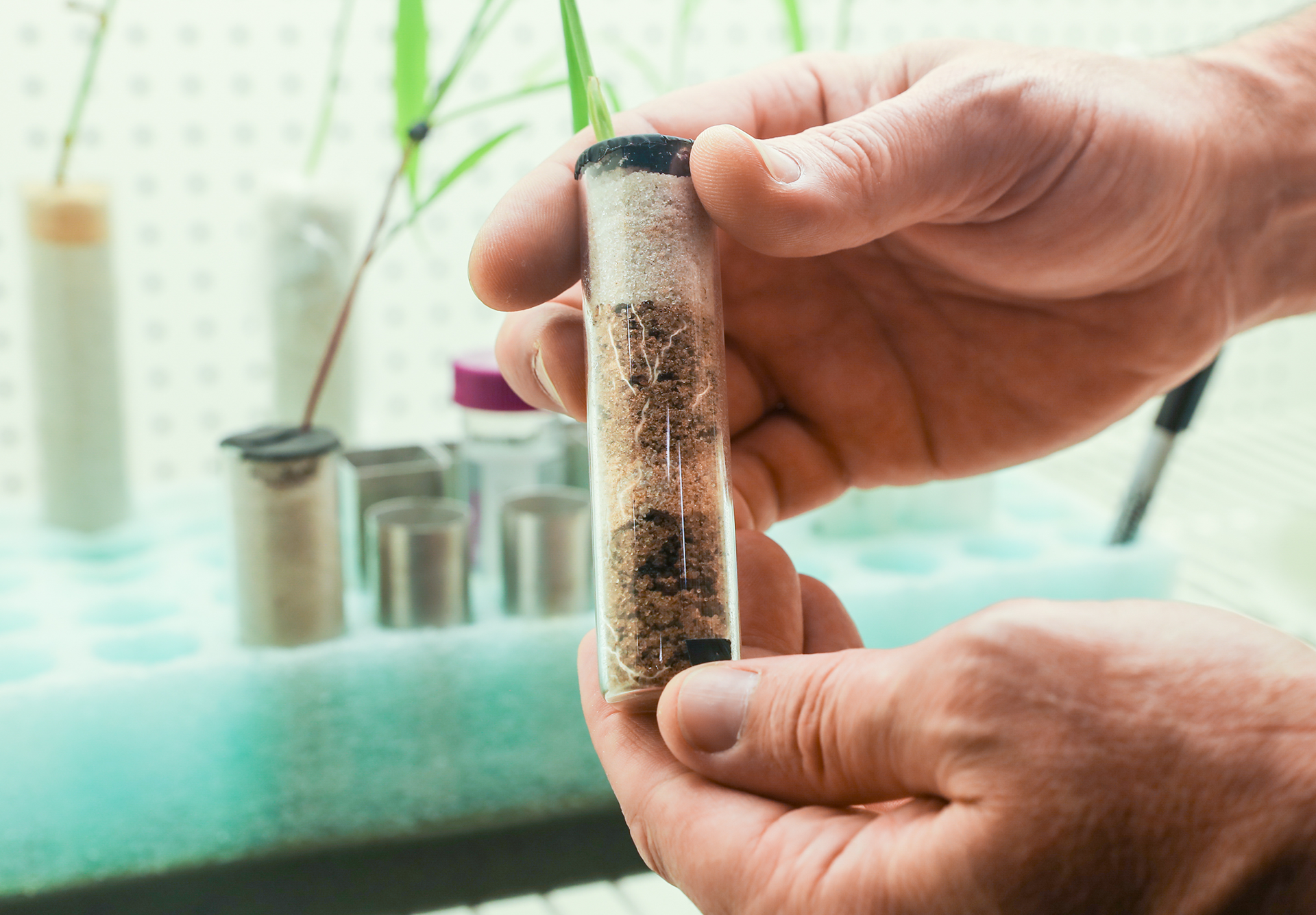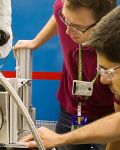Corn is a seemingly simple plant, but underground it has a very complicated life.
When scientists develop environmental and climate computer models, they take into account a wide variety of processes, such as photosynthesis, respiration rates, soil conditions, carbon allocation, nutrient extraction, litter decomposition rates—and that’s just for plants. Yet despite decades of scientific studies and modeling, below-ground root dynamics in plants are a “black box,” because quantifying how water and nutrients from the soil pass into plant roots at microscopic scales has remained elusive.
This is why details about the dynamic functions of roots are mostly absent from terrestrial biosphere models, or are greatly simplified by using fixed parameters. However, root activity has been shown to be highly variable and have substantial impacts on soil properties, including water retention, water flow rate, and the uptake of nutrients, chemicals, and pollutants in the ground. Capturing root dynamics and their impacts on soil moisture “on camera” in 3-D and in real-time would allow a better representation of roots for modeling.
To make it easier to study and understand root activity, scientists are using neutrons to develop new methods of neutron imaging at the High Flux Isotope Reactor (HFIR) located at the Department of Energy’s (DOE’s) Oak Ridge National Laboratory (ORNL). Neutrons are highly penetrating and nondestructive, properties that permit scanning through sandy soil, which in combination with novel algorithms (sequences of instructions telling a computer what to do), enabled the researchers to capture neutron CT images of roots faster while observing them for longer periods of time to accurately record root activity in real-time.
“Neutron Computed tomography, or CT, uses neutrons to look inside objects without slicing them open, similar to the x-ray CT scans used in medical applications,” said Jeff Warren, senior staff scientist for ORNL’s Environmental Sciences Division. “Directly applying conventional CT methods to image objects that are changing during a scan can be extremely challenging. That’s why we are developing algorithms that collect data much more quickly along with algorithms to capture complete images of root dynamics, something that will help further research to reduce uncertainty in future terrestrial biosphere models.”
ORNL used neutron CT scanning and an algorithm to study root dynamics in 3-D and real-time. Credit: ORNL/Genevieve Martin
New, non-invasive scanning techniques are needed, because direct physical sampling of soil water and roots can damage the rhizosphere (the area around plant roots inhabited by a unique system of microorganisms) and xylem (vascular tissue in plants that conducts water and dissolved nutrients from the roots), causing misinterpretations of root function data. Installing soil or plant water sensors is similarly invasive and only captures bulk data at single points that do not link water uptake to individual root characteristics. Despite the challenging nature of collecting the data, the algorithms being developed at ORNL are powerful enough that they can accurately reconstruct an object in real-time.
“We are also developing artificial intelligence-based algorithms in order to obtain high-fidelity images, which is a technique that is becoming more and more popular in the field of CT ,” said Singanallur “Venkat” Venkatakrishnan, research staff scientist in ORNL’s Electrical and Electronics Systems Research Division. “We are training machine learning models to produce higher-quality images of root structures and root activity from extremely complex CT data in a fraction of the time typically required by more complex methods.”

Singanallur “Venkat” Venkatakrishnan helped develop an algorithm to obtain real-time, fast CT images of intricate plant root systems and their functions. Credit: ORNL/Genevieve Martin
“One of our goals was to visualize in 3-D how fast water moves through the soil and is taken up into the roots, which previously was limited to visualizing 2-D images of roots compressed between thin plates,” said Warren. “The neutron imaging facility at HFIR helped us observe and record the uptake process in exposures from 0.1 to 10 seconds long to capture the water uptake in real-time instead of as just individual snapshots.”
The new, faster experiments produced more than 2 terabytes of data (over 160,000 high-resolution images). CT reconstructions from the data will be compared against independent soil water flow models to validate and refine the representations of 3-D water flow between soils and roots. Results can be used to inform the development of more advanced terrestrial biosphere models that include soil hydraulics—a current priority for the DOE Office of Science.
The initial success of using fast neutron CT to obtain high-resolution images of root functions is encouraging. This technique could eventually be used to capture entire root scans in under 10 minutes—and eventually in less than 90 seconds per scan—to dramatically improve the temporal resolution of the HFIR imaging instrument.
The project was supported by the DOE Office of Science.
Looking ahead to the Second Target Station. The Second Target Station (STS) at ORNL will provide transformative new capabilities for discovery science, enabling breakthroughs in many areas of materials research and development. One of the initial STS instruments, CUPI2D, will greatly expand research capabilities in experiments on natural materials, such as the corn plants used in the CT scans.
CUPI2D, will significantly improve the capability to image dynamic processes in natural and engineered materials, including scientific studies on energy storage and conversion (e.g., batteries and fuel cells), materials engineering (e.g., additive manufacturing and advanced superalloys), nuclear materials (e.g., novel fuel cladding and moderators), biology and ecosystems, and medical and dental applications.
HFIR is a DOE Office of Science user facility. UT-Battelle LLC manages ORNL for the DOE Office of Science. The Office of Science is the single largest supporter of basic research in the physical sciences in the United States and is working to address some of the most pressing challenges of our time. For more information, please visit www.energy.gov/science.
–by Paul Boisvert










